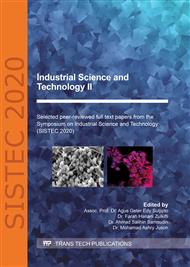p.53
p.60
p.69
p.77
p.82
p.91
p.97
p.104
p.110
Potential of Seaweed (Kappaphycus alvarezii) as a Particleboard
Abstract:
Recently, the utilization of lignocellulosic materials to produce eco-friendly products is very promising as biodegradable reinforcing elements for composite materials like particleboards and medium density fiberboards. The growing shortage of wood supply has also led to the development of suitable alternative materials for construction. For this reason, the industry is working to develop high-efficiency green materials including the use of seaweed. This research is aims to study the potential of seaweed from Kappaphycus species as a particleboard. Several different target densities were produced according to following proportions: seaweed particles from 150 to 200 grams and UF resin from 15% to 20%. Mechanical properties including internal bonding and bending testing were tested in this study. Samples were also investigated by utilizing microscopy for surface characterization. The outcome showed that seaweed particleboard with highest amount of seaweed particle and UF resin resulted in highest MOE, MOR and internal bonding strength values with results 457.47, 1.5, and 4.73 MPa, respectively. According to Japanese Standard, Internal bonding (IB) strength values for all the samples met the IB requirements of the standards for general uses. Thus, seaweed particle has potential to be an alternative raw material in the manufacture of particleboards.
Info:
Periodical:
Pages:
82-87
Citation:
Online since:
March 2021
Authors:
Keywords:
Price:
Сopyright:
© 2021 Trans Tech Publications Ltd. All Rights Reserved
Share:
Citation:


